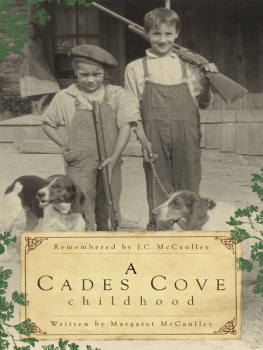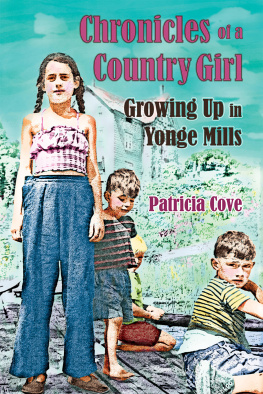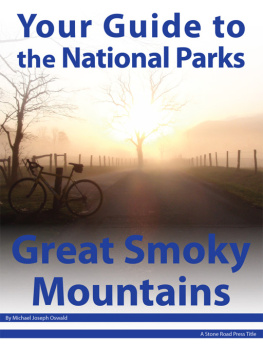

My first school photograph at ten years old.

Published by The History Press
Charleston, SC 29403
www.historypress.net
Copyright 2008 by Margaret Osborne McCaulley
All rights reserved
Cover design by Marshall Hudson.
First published 2008
Second printing 2011
Third printing 2011
Fourth printing 2012
e-book edition 2013
Manufactured in the United States.
ISBN 978.1.62584.377.7
Library of Congress Cataloging-in-Publication Data
McCaulley, J. C., 1929
A Cades Cove childhood / [transcribed by] Margaret Osborne McCaulley ; remembered by J.C. McCaulley.
p. cm.
print edition ISBN 978-1-59629-556-8
1. McCaulley, J. C., 1929---Childhood and youth. 2. McCaulley, J. C., 1929---Family. 3. Cades Cove (Tenn.)--Social life and customs--20th century. 4. Cades Cove (Tenn.)--Biography. 5. Mountain life--Tennessee--Cades Cove--History--20th century. 6. Farm life--Tennessee--Cades Cove--History--20th century. 7. Blount County (Tenn.)--Social life and customs--20th century. 8. Blount County (Tenn.)--Biography. I. McCaulley, Margaret Osbo rne. II. Title.
F443.B6M24 2008
976.8885--dc22 2008027629
Notice: The information in this book is true and complete to the best of our knowledge. It is offered without guarantee on the part of the author or The History Press. The author and The History Press disclaim all liability in connection with the use of this book.
All rights reserved. No part of this book may be reproduced or transmitted in any form whatsoever without prior written permission from the publisher except in the case of brief quotations embodied in critical articles and reviews.
CONTENTS

This book is dedicated to the memory of my parents, John and Rutha McCaulley, 1959. Courtesy of Trish McCaulley Abbott.
ACKNOWLEDGEMENTS
I would like to thank the people who helped me with this book.
My friend and mentor, Jane Jensen, who encouraged me to begin.
My sister, Mary Upton, whose example inspired me and who kept my nose to the grindstone through one interstate move, two hospital stays and various other crises!
Linda Weaver, who began by advising me on many aspects of putting a book together, and became a friend over many cups of tea and cookies.
Various members of the extended McCaulley clan, who gave me old photos, contributed a few stories, occasionally jogged my husbands memory and were generally interested and enthusiastic.
And of course, that little fellow on the back covermy beloved husband and best friend.
INTRODUCTION
Cades Cove is a large fertile valley surrounded by mountains, threaded by streams and lying the in easternmost part of Tennessee. Within living memory, it was a viable farming community, inhabited by independent people descending from settlers who first came to a wild and remote area in the 1700s. Now it is a focal point in the most visited national park in the United States. An eleven-mile road circles the valley, and visitors may stop to view log cabins once occupied by the earliest settlers and three churches whose bells once rang to summon them to services on Sunday.
The people of the Cove began to sell their property, most against their will, when the government decided to form the Great Smoky Mountains National Park and started to acquire land in the mid-1920s. Some fought in the courts to retain their homesteads, but it was a losing battle. Some, accepting the small sums they received for their property, left and settled in nearby counties and towns. Many of the older people never recovered from the shock of leaving and, unhappy in their new environments, died shortly thereafter.
The earliest arrivals, and some land speculators, claimed land in the flatter part of the Cove. This land was the most desirable, and soon filled up, being easier to farm. Later arrivals had to locate farther back in the hills, where they cultivated the hillsides and eked out a living as best they could, supplementing their income by cutting timber, trapping and occasionally making whiskey. The population of the Cove rose and fell, numbering about seven hundred people at its peak. Considering the limited amount of tillable land, such numbers began to strain the resources of the area, and by 1900 a steady decline began as people left to seek opportunities elsewhere. Some went to Georgia, particularly when gold was discovered near Dahlonega; others went west to Kansas, Missouri or Arkansas. The ones who remained either had larger farms with more tillable land, or were tough and resourceful enough to exploit every possible way to make the cash they needed for taxes and the commodities they could not raise or manufacture.

I am standing on the porch of the Witt-Shields house in Cades Cove, 1955. Courtesy of the author.
The log cabins seen today were, in the later stages of the Coves history, often replaced by substantial houses of planed lumber, which have since been removed by the National Park Service. A particularly attractive example was the Witt-Shields house, which was demolished in the later 1950s. When I lived in the Cove, it was occupied by Alphonse Fonze Cable and his family. Mr Cable was a bear hunter and owned excellent bear dogs, so he and my father were friends and I often accompanied my parents there on visits. There were schools and several stores; the community had telephone service as early as the late 1890s; and the Coves social events were regularly reported in a special column in the Maryville Times, including family visits, quilting bees, church events and picnics.
The sacrifice of such a community, however sad, was not in vain. The national park serves an invaluable purpose in preserving vast stretches of unspoiled mountains and forests, providing a haven for wildlife, trails for hiking and horseback riding, fishing, camping and a retreat from our all-too-hectic lives.
Few people who were actually born and remember living in the Cove now remain, but their children and grandchildren are proud of their heritage and cherish what remains of those times.
When my wife came from England to marry me, she was warmly welcomed into my Cove family. On many Sunday afternoons we sat and talked under the maple trees at my parents farm. After years away from their mountain home, they still told Cove stories many times over until, she said, they almost seemed part of her own history. Here are a few of those stories and recollections of my childhood.
MY FAMILY
I am J.C. McCaulley, the son of John Thomas and Rutha Angeline Myers McCaulley. I was born in Cades Cove in 1929, the last of nine children. The family lived there until 1936, when we left our home to settle on Whites Mill Road at Hubbard, near Maryville. We were among the last residents to leave the Cove, my parents having sold our seventy-five acres to the Park Service.
My father was the last son of James, the first McCaulley to settle in Cades Cove. Little is known about Jamess people, but at the beginning of the Civil War, we know he was living in the small settlement of Walland, Tennessee, with his wife Unity Elizabeth Caldwell. They had one child and were expecting another. Most of Blount County was pro-Union and so was Jamesat the age of thirty, he went to enlist in the Union army. Tennessee earned its nickname (the Volunteer State) because it sent more men to the warto both sidesthan any other state. With several friends, James walked to Kentucky to enlist in the Third Tennessee Cavalry, first serving as a cook and then as a blacksmith, which was his trade. Surviving the war safe and whole, he was discharged at Pulaski, Tennessee, in 1865 and made his way home to Walland to be reunited with his wife and children.
Next page

















